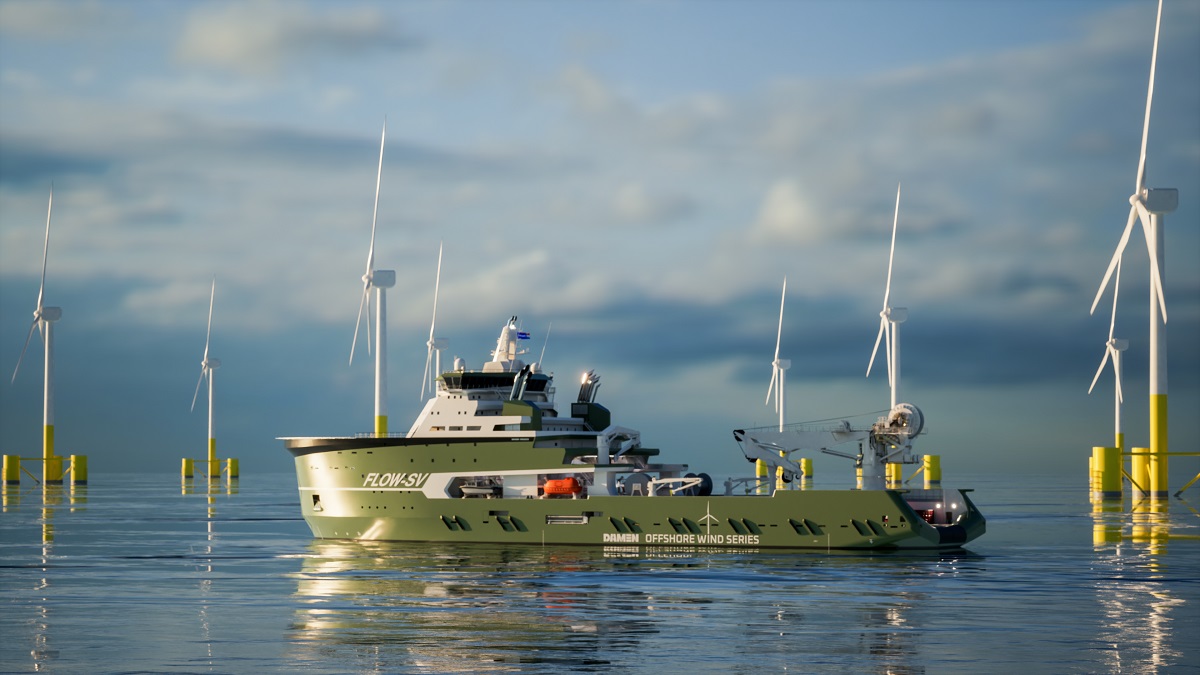
Damen unveils new design for floating wind industry

Conceptual design of the FLOW-SV (Source: Damen)
Netherlands-based Damen Group has unveiled details of a conceptual design for a multi-function vessel capable of supplying, installing, securing and inspecting the components of floating wind structures.
The size and weight of components necessary for the siting of floating wind farms in deeper waters has required the development of a much larger vessel concept. The FLOW-SV vessel, with a length of about 150m and a 32m beam, will be capable of installing and securing up to nine anchors or suction piles, thereby enabling the positioning of three floating turbines in a single mission, rather than just one.
Damen engineers calculated that the installation of three floating turbines in a water depth of 100m would require the FLOW-SV to have capacity for 5km of chain (with links of 152mm), 4.5km of 112-mm fibre rope, nine anchors each weighing 15 tonnes, and almost 100 clump weight of 10 tonnes each. D-shackles, tensioners, and steel cable would also be required. In total, the components would weigh more than 4,000 tonnes, the experts said.
Damen’s Wijtze van der Leij, sales manager, explained: "With the FLOW-SV, we have developed a vessel which covers the entire process of attaching mooring lines. This vessel, combining the supply, installation, securing and inspection of the ground tackles for floating turbines in one vessel, introduces a big step forward towards large scale installation of floating wind farms.
“The concept reflects our expertise in operational demands and efficiency,” he continued. “At the moment, we are still in the concept phase. But we are now entering a stage where we would like to partner up to refine and customise this concept. Together with a launching customer, we aspire to accelerate the floating offshore wind farm installation industry.”
The ship has been designed to operate using methanol, and tanks and piping will comply with the safety regulations for this future fuel. It will have a sophisticated and complex range of combinations to meet component handling and installation requirements. For anchor deployment at sea, the chain will be guided to large winches on the forward end of the large open after deck, Damen explained, where it is then passed over the deck to the stern to enter the water.
When the floater anchors are being secured and maximum bollard pull is needed, two 5.5m propellers in nozzles are engaged. However, on transit voyages, the ship will deploy two azimuthing 4.5m propellers. No rudders are required.
An active-heave-compensation crane with lifting capacity of 250 tonnes at an outreach of 12.5m will be installed on the starboard side of the aft deck, according to the design. Meanwhile, two smaller cargo rail cranes are available for handling components on deck. A triple-drum anchor winch has a pulling force of 600 tonnes.
A combination of bollard pull from two azimuthing stern thrusters and pulling force from the bow reaction anchor winch provides up to 1,000 tonnes of proof load, Damen said. When the bow anchor is deployed, the vessel embeds it by reverse bollard pull. The vessel then moves to the place over which the anchor for the floating turbine is to be installed.
Explaining the process, Damen said in a statement: “After letting out enough chain length, the anchor for the floater needs to be proof-loaded, ensuring a secure seabed connection. Using the four thrusters, FLOW-SV has 400 tonnes of bollard pull. Pulling strength is enhanced by the forward anchor handling winch that generates another 600 tonnes. At that moment, approximately 1,000 tonnes of proof-load are acting on the turbine floater anchor.”
To ensure that anchors are placed in the best positions, the seabed must be inspected. The FLOW-SV therefore has two remotely operated vehicles (ROVs) with two separate control rooms next to a moonpool amidships. After installation, anchors and their position can be inspected by the ROVs to ensure a sufficiently strong grounding in the seabed.
Some analysts have suggested that few vessels available today are suitable for offshore floating wind installations in deeper waters. Large anchor handlers lack the necessary carrying capacity, the power requirements, and are engaged on other projects, Damen said, suggesting that up to 100 ships of this type could be needed.
Other companies engaged in aspects of the FLOW-SV design include First Marine Solutions, Intermoor, Kongsberg, McGregor, and Temporary Works Design.
